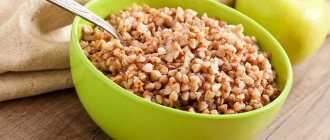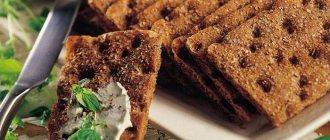Beneficial properties of buckwheat with milk
Milk buckwheat porridge is nutritious due to the high protein content in the cereal, a large amount of vitamins and minerals. Both ingredients do not lose their beneficial properties during heat treatment. Warm milk better reveals the taste and aroma of buckwheat.
Buckwheat porridge contains the following beneficial substances:
- polyunsaturated fatty acids omega-3 and omega-6 promote the absorption of proteins and fats, reduce cholesterol levels and the risk of cardiovascular diseases;
- flavonoids, which have anti-inflammatory properties, reduce the fragility of blood vessels and, being antioxidants, protect cells from free radicals;
- iron reduces fatigue;
- phosphorus prevents bone diseases;
- B vitamins have a positive effect on the functioning of the brain and nervous system.
Buckwheat is a hypoallergenic product, so it can be eaten by people prone to allergies. In combination with milk, it helps remove toxins from the body during poisoning and radiation. Porridge helps restore liver cells, so it is included in the diet of patients in medical rehabilitation centers.
Buckwheat with milk is given to children from 8 months, as the risk of allergies is minimal, and vitamins and minerals are easily absorbed. Athletes regularly eat this porridge to strengthen muscles and blood vessels, as well as to increase the body's endurance. Elderly people benefit from milk porridge to normalize blood pressure and cholesterol levels, and protect blood vessels from blockage.
Possible harm
Many different articles, including contradictory ones, have been written separately about the dangers of milk and buckwheat porridge. However, in fact, health problems can arise only with an excess amount of these products in the diet, namely with a significant limitation in the composition of the daily menu.
A long-term mono-diet threatens a deficiency of vitamins and minerals, brittle nails and hair, and disruption of the digestive system. In addition, some people experience severe intolerance to whole milk, which may limit the use of this diet. If there is a lack of digestive enzymes, a person losing weight may also experience frequent attacks of flatulence.
Be sure to read: List of spices for effective weight loss
Calorie content, BJU and glycemic index of buckwheat with milk
Buckwheat porridge contains slow carbohydrates, which means it saturates the body with energy for a long time. And the high protein content gives muscle tone.
Content of proteins, fats and carbohydrates (BJU) in buckwheat with milk per 100 g of dish:
- proteins - 6.7 g;
- fats - 2.2 g;
- carbohydrates - 27.7 g.
Calorie content of 100 g of porridge is 151.6 kcal.
Milk buckwheat porridge is often prepared with the addition of other ingredients. The table shows calorie content and dietary fat per 100 g, taking into account added products.
| Type of dish | Calorie content, kcal | BZHU, g |
| With sugar | 92,05 | 2,97 / 3,35 / 12,58 |
| With milk without sugar and butter | 74,57 | 3,14 / 3,54 / 7,6 |
| With butter | 110,97 | 3 / 7,81 / 7,23 |
| With honey | 87,02 | 3,03 / 3,37 / 11,21 |
| With sugar and butter | 125,69 | 2,58 / 7,41 / 11,97 |
The glycemic index (GI) of a product is important to know for those who monitor their blood sugar levels or want to eat food that fills them for a long time. The index shows how quickly carbohydrates in a dish are converted into sugar.
The GI of boiled buckwheat with milk is 33 units. This is a low indicator, which indicates that carbohydrates are slowly absorbed in the body and evenly saturate the blood with sugar. This does not overload the pancreas. The energy released is not converted into fat and lasts for several hours.
The GI of buckwheat with milk varies depending on the ingredients added to the porridge. For example, when sugar is added, the indicator increases: blood sugar levels rise quickly and a large amount of energy is released. If this energy is not used up, it is converted into fat.
Is the dish effective for weight loss?
If you want to lose excess weight, monitor the glycemic index, which should be up to 55 units. Therefore, buckwheat with milk is included in the diet menu. A small portion of such porridge saturates the body for a long time, and the high content of vitamins and minerals in the dish heals the body.
Attention! It is recommended to choose whole grain cereals rather than crushed ones. Prepare the porridge without sugar, and after cooking add a little honey.
The benefits of buckwheat and milk
Both buckwheat and high-quality milk have a lot of benefits for the human body. In the case of buckwheat porridge, the following properties are of great importance:
- rich and varied chemical composition (B vitamins, vitamin A, potassium, magnesium, iron, manganese, selenium, zinc, iodine, etc.);
- complex carbohydrates in the composition ensure slow absorption, due to which the feeling of fullness does not go away for a long time;
- A large amount of easily digestible protein (12.6 g per 100 g of product) allows you to use buckwheat as part of your diet.
Buckwheat is famous for its rich vitamin and mineral composition.
Milk also contains a lot of useful things; the product has a rich vitamin and mineral composition:
- choline;
- B vitamins;
- vitamin A;
- ascorbic acid;
- calcium;
- sodium;
- magnesium;
- sulfur;
- potassium;
- phosphorus, etc.
Milk combines several types of proteins, as well as beneficial amino acids, which increases its value.
Milk is beneficial for humans due to its high calcium content.
Is it possible to eat buckwheat with milk and why not?
It is recommended to include milk buckwheat porridge in the menu 2-3 times a week. It can be eaten for breakfast and dinner. In the morning it will give a boost of energy and saturate the body with vitamins for a long time. And in the evening it will relieve the feeling of heaviness and help you sleep.
Reference. Buckwheat contains large amounts of the bioflavonoid rutin, which helps treat depression.
During pregnancy and pregnancy
It is useful for pregnant and lactating women to eat buckwheat with milk due to the high content of vitamins and minerals, fiber and low GI. Zinc in the porridge improves the functioning of the ovaries, supports sexual activity and helps to avoid hormonal imbalance.
The beneficial substances in these products are involved in the development of the endometrium, to which the fertilized egg is attached.
For diabetes
It is important for people with diabetes to monitor the GI of all foods they eat. If it is above 70 units, these products are excluded from the diet.
Buckwheat porridge with milk is not contraindicated for diabetics; on the contrary, it is beneficial due to the slow absorption of carbohydrates and a gradual increase in blood sugar. This is facilitated by fiber and amino acids in the dish.
For gastrointestinal diseases
Buckwheat with milk is useful for gastrointestinal diseases: pancreatitis, diseases of the stomach and duodenum beyond the acute stage. Porridge weakens the symptoms of diseases, promotes wound healing, coats the mucous membranes of the digestive organs, and helps the body recover faster from illness.
For constipation
Buckwheat has a mild laxative effect, so it helps with constipation. It also protects the mucous membranes of the intestinal organs and reduces the symptoms of irritation of the digestive organs. However, for constipation, buckwheat is cooked in water, since milk has the opposite effect.
Contraindications and course limitations
The effectiveness of the diet has been proven by many practitioners. However, it is categorically not recommended for everyone to use it due to the presence of restrictions and contraindications. Among the main ones:
- Pathologies of the digestive system;
- Diabetes;
- Excessive amount of iron in the blood;
- Heart attacks and strokes;
- Atherosclerosis;
- Hypersensitivity to cereals or lactase deficiency;
- Calcium deficiency;
- Liver dysfunction.
Be sure to read: Simple recommendations on how to lose 6 kg in a month
Long-term use of the diet is prohibited for pregnant women and nursing mothers. However, if you are overweight, it is recommended to carry out gentle fasting days once or twice a week with milk and buckwheat porridge. In this case, it is possible to supplement the diet with a small amount of cottage cheese, vegetables and fruits.
Fasting days are indicated if the following problems exist:
- Constant swelling;
- Excess weight and too high body mass index;
- Preeclampsia;
- High blood pressure.
Before using the diet, you should consult your doctor. It is recommended to undergo a comprehensive medical examination first. Throughout the course, it is also useful to periodically monitor changes in the body’s condition and check it for complications.
Recipes for cooking buckwheat with milk
There are many options for preparing buckwheat porridge. It is boiled, steamed in a thermos and baked in the oven. We offer several recipes for this delicious porridge.
Buckwheat porridge cooked in water and milk
This is a classic recipe for buckwheat milk porridge.
Ingredients:
- 1 glass of buckwheat;
- 1.5 glasses of cold water;
- 0.5 glasses of milk;
- 0.5 tsp. salt.
Preparation:
- Rinse the cereal with running water, pour into a saucepan, add water and milk, cover with a lid and put on high heat.
- Bring the porridge to a boil, add salt and stir. Cover with a lid, leaving a small gap.
- Cook over low heat until the water evaporates from the surface.
- Cover the porridge completely with a lid and cook for another 10 minutes.
- If desired, add butter, sugar or honey to the finished porridge.
Buckwheat porridge steamed in a thermos
The most useful option for preparing buckwheat, because minimal heat treatment of cereals and milk is carried out.
Ingredients:
- 1 glass of buckwheat;
- 1.5 cups boiling water;
- 2 glasses of milk;
- a pinch of salt.
Preparation:
- Preheat the thermos with boiling water, add cereal, pour boiling water over it, add salt.
- Close the lid tightly and shake the thermos vigorously to mix everything.
- Leave to steam at room temperature for 1.5-2 hours.
- Place the finished porridge in a convenient container and pour in warm milk.
What could be the harm of buckwheat with milk?
Despite many positive properties, this porridge can be harmful, therefore it has a number of restrictions for consumption:
- Buckwheat contains iron, and milk contains a lot of calcium. Together, these two substances are not fully absorbed by the body. Therefore, such porridge is eaten at normal hemoglobin levels.
- To digest buckwheat and milk, different enzymes are needed. The load on the digestive organs increases.
- Due to the enveloping properties of porridge, the absorption capacity of the digestive organs is reduced.
- For metabolic and hormonal disorders, endocrinologists recommend eating this porridge infrequently, a maximum of once a week.
- The beneficial properties of milk decrease when heated and boiled, so it is recommended to add it to boiled cereals.
Contraindications for use
You should avoid buckwheat with milk if you have the following diseases:
- lactose intolerance, which means you cannot consume dairy products;
- hemochromatosis, in which iron is not absorbed by the gastrointestinal tract, but accumulates in the muscles and bones;
- allergy to buckwheat;
- severe urolithiasis;
- stomach ulcer and gastritis in the acute stage.
This is interesting:
How does buckwheat affect the blood: does it thicken or thin it, and can it be eaten if you have high cholesterol?
How does buckwheat affect stool: does it strengthen or weaken?
How to take buckwheat with kefir in the morning if you have diabetes
Barley porridge with milk. How to cook delicious barley porridge with milk?
In Rus', for a long time, one of the most significant dishes that should always be present on the table was porridge. A sufficient amount of cereals is used for their preparation. But at the same time, over the past few decades, much less attention has been paid to products of this type, which is not at all justified, and sometimes even harmful to the body.
Benefits and harms
Not a single nutritionist, if he really values his own reputation, will say that there is food, the use of which will be equally beneficial for all categories of people. Barley porridge is no exception. Crushed barley is used to prepare it, and depending on the size of the kernels, we can talk about assigning a variety.
In this case, the primer is not amenable to the grinding process, making it even more possible to preserve the maximum amount of fiber. Cleaning from organic and mineral impurities is also carried out. The composition of barley groats includes vitamins known for their beneficial qualities such as A, PP, E, as well as B vitamins. As for microelements, the highest concentration belongs to magnesium, iron, calcium, and potassium.
Regular consumption of barley porridge is necessary for people who have problems with the functioning of the stomach and intestines, which is due to its significant (about 6%) fiber content. Thanks to it, the process of cleansing the body of toxins and normalizing the digestive process occurs. But if you have recently had surgery, you should consult your doctor before eating barley porridge.
The protein content in barley porridge is also significant, and in terms of its nutritional value it is much better than a similar substance found in wheat groats. Its ability to be fully absorbed can also be considered a positive aspect. In terms of its nutritional value, barley porridge is quite useful, as it helps satisfy hunger for a minimum period and does not subsequently face the need to get rid of extra pounds.











